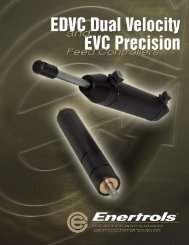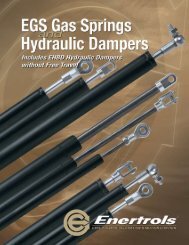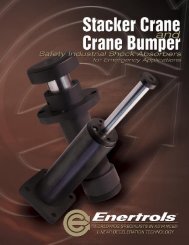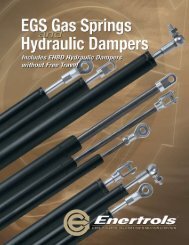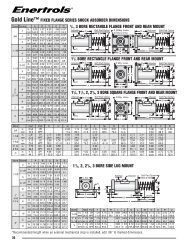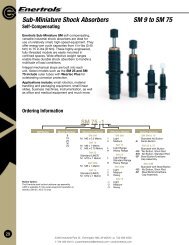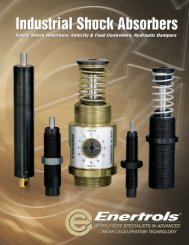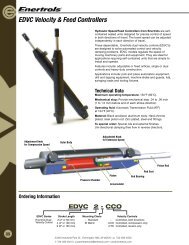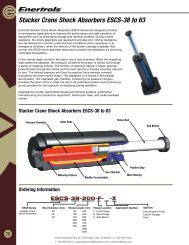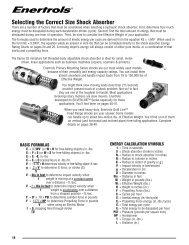View the Enertrols Main Catalog featuring industrial shock ...
View the Enertrols Main Catalog featuring industrial shock ...
View the Enertrols Main Catalog featuring industrial shock ...
You also want an ePaper? Increase the reach of your titles
YUMPU automatically turns print PDFs into web optimized ePapers that Google loves.
Selecting <strong>the</strong> Correct Model Shock AbsorberThe model type of an <strong>Enertrols</strong> <strong>shock</strong> absorber is determined by:• Type of accumulator–self-contained or external air/oil tank (AOT)• Method of piston rod return–spring, air or mechanicalModel and mounting selection are usually determined by <strong>the</strong> application. Self-contained models are generallypreferred over <strong>the</strong> external accumulator-equipped models. They are pre-filled at <strong>the</strong> factory and ready to use whenreceived. No external piping or o<strong>the</strong>r system components are required.Because <strong>Enertrols</strong> <strong>shock</strong>s stop a moving object in less time than non-linear decelerating devices, you shouldselect a unit with <strong>the</strong> longest possible stroke that can be accommodated without exceeding side-loading limits.This will minimize impact forces on <strong>the</strong> mounting structure and <strong>the</strong> moving object being stopped.AccumulatorsWith internal accumulator models, <strong>the</strong> fluiddisplaced by <strong>the</strong> piston rod under impact isforced against a nitrogen-filled, closed cellsponge in <strong>the</strong> body of <strong>the</strong> <strong>shock</strong> absorber. As <strong>the</strong>piston rod is returned, <strong>the</strong> sponge expands tohelp force fluid back into <strong>the</strong> high-pressure tube.Where conditions permit, internal accumulatormodels are preferred.Where more energy per hour (E 4), or heatdissipation is needed, as found in high duty-cycleapplications, or high-temperature environments,external accumulator models should be used.The external accumulator is a tank or reservoir,ei<strong>the</strong>r open or closed to atmosphere, that isconnected to <strong>the</strong> <strong>shock</strong> absorber with appropriatesize piping. The oil flows back and forthbetween it and <strong>the</strong> <strong>shock</strong> absorber, helping tocool <strong>the</strong> oil as <strong>the</strong> unit is cycled. The air/oil tank(AOT) of external accumulator-equipped modelsmust be above <strong>the</strong> <strong>shock</strong> absorber and shouldbe located as close to <strong>the</strong> <strong>shock</strong> absorber aspossible. A 10-micron filter, installed between <strong>the</strong>exit of <strong>the</strong> air/oil tank and <strong>the</strong> <strong>shock</strong> absorber, isrecommended.Type ofAccumulatorMethod ofPiston Rod ReturnInternal Spring SAModelInternal Spring SALDExternal Air (or Mechanical) ALDInternal Mechanical ALDAExternal Spring ALDSInternal Spring (self-compensating) SMInternal Spring (self-compensating) SNALDExternal Air or Mech. (self-compensating) NALDInternal Spring (SILVERLINE) SASLExternal Air (SILVERLINE) ASLExternal Spring (SILVERLINE) ASLSInternal Mechanical (SILVERLINE) ASLAGeneral InformationIf <strong>the</strong> AOT must be located at a substantial distance from <strong>the</strong> <strong>shock</strong> use a positive oil recirculation circuit (Fig 2B).O<strong>the</strong>rwise, oil may simply move back and forth in <strong>the</strong> lines and never reach <strong>the</strong> tank to be cooled.Piston Rod ReturnThe return of <strong>the</strong> piston rod is accomplished in one of three ways (spring, air/oil, or mechanically). Mechanicalreturns usually make use of clevis-mounting designs and may be operated by a lever arm actuated by some o<strong>the</strong>rmoving part of <strong>the</strong> equipment. On self-contained models, or air/oil models with a spring, an externally mountedspring returns <strong>the</strong> rod when <strong>the</strong> load is removed.FIGURE 2A B CIn external accumulator models, an air/oil system, or some o<strong>the</strong>rmechanical means, must be used to return <strong>the</strong> piston rod. ALD modelspermit a variable rate of rod return, time delay and/or lower rod returnforces. This is accomplished by adding a pressure regulator (Fig. 2B)to <strong>the</strong> air/oil system, or by adding a 3-way valve and pressure regulator(Fig. 2C) to <strong>the</strong> system.ALDS models are shipped with a rod return spring installed. Thus, even when an external accumulator is used toimprove heat dissipation, it need not be pressurized. The spring will provide <strong>the</strong> necessary rod return force. Forbest results, <strong>the</strong> accumulator should be vented to <strong>the</strong> atmosphere with a filter/brea<strong>the</strong>r unit. Recommended airpressure for air oil tanks is 70-100 psi depending on <strong>the</strong> application.23435 Industrial Park Dr., Farmington Hills, MI 48335 • p: 734-595-4500f: 734-595-6410 • customerservice@enertrols.com • www.enertrols.com10




